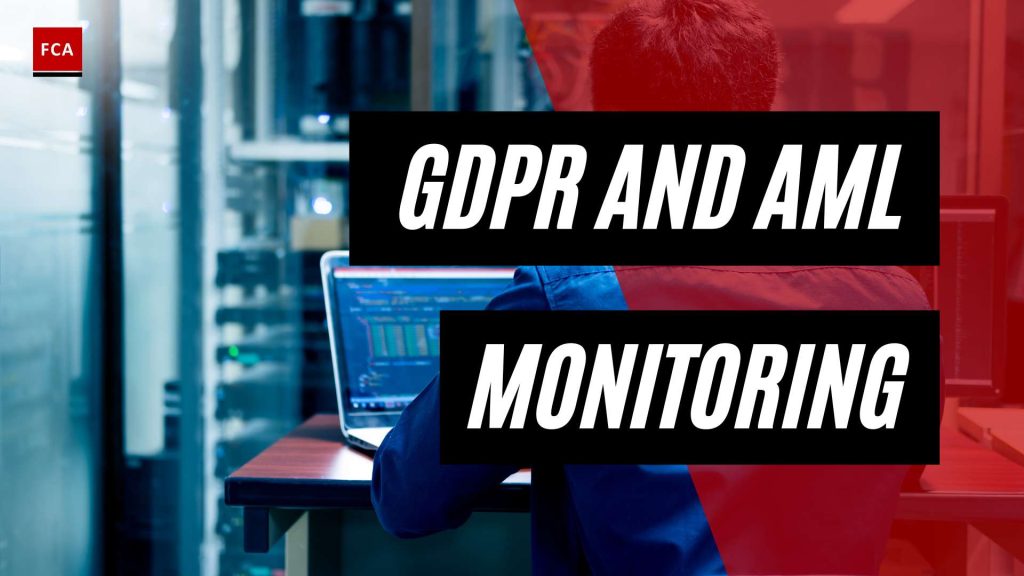Understanding GDPR and AML Compliance
In the realm of AML (Anti-Money Laundering) compliance, it is crucial to understand the intersecting requirements of the General Data Protection Regulation (GDPR) and AML regulations. The GDPR, a comprehensive data privacy law, and AML regulations, aimed at combating money laundering and terrorist financing, are both essential components of regulatory frameworks that financial institutions must navigate.
An Overview of GDPR
The GDPR is an EU-wide data privacy law that seeks to strengthen individuals’ fundamental rights to personal information and privacy in the digital age. It extends its reach beyond the EU, requiring businesses that provide goods or services to EU nationals to comply with its provisions, regardless of their location. Noncompliance with GDPR can result in severe fines, amounting to up to 4% of global annual sales or 20 million euros, whichever is higher (Flagright).
The GDPR places a strong emphasis on ensuring that personal data is processed lawfully, transparently, and securely. It grants individuals a range of rights, including the right to access their data, the right to rectify inaccuracies, the right to erasure (under certain conditions), and the right to data portability. These rights empower individuals to have greater control over their personal data.
Anti-Money Laundering (AML) Compliance
AML compliance is a critical aspect of the financial industry, designed to prevent money laundering and the financing of criminal activities. AML regulations require financial institutions to establish robust systems and processes to detect and report suspicious transactions.
Financial institutions are obligated to perform customer due diligence, which involves verifying customer identities, assessing the risks associated with their business relationships, and monitoring transactions for potential money laundering activities. These measures help identify and report suspicious activities to relevant authorities.
AML compliance requirements vary across jurisdictions, but they share a common goal of safeguarding the integrity of the financial system and protecting it from abuse.
Understanding the interface between GDPR and AML compliance is essential for financial institutions as they navigate the regulatory landscape. The overlapping requirements and potential conflicts between these two frameworks necessitate careful consideration of data protection and privacy while fulfilling AML obligations. In the following sections, we will explore the interface between GDPR and AML compliance, as well as the challenges and considerations in achieving effective compliance in transaction monitoring.
The Interface Between GDPR and AML
When it comes to the interface between the General Data Protection Regulation (GDPR) and Anti-Money Laundering (AML) compliance, financial institutions face unique challenges. Both GDPR and AML regulations aim to protect sensitive information and ensure data accuracy, but they have different focuses and requirements. Understanding the interface between these two regulatory frameworks is crucial for maintaining compliance in transaction monitoring practices.
Personal Data Processing in AML
AML regulations heavily rely on personal data, such as customer identification information, transaction details, and suspicious activity reports. Financial institutions are required to collect and process this data to fulfill their AML obligations. However, the processing of personal data in AML can create conflicts with GDPR restrictions, as GDPR imposes strict rules on the collection, storage, and processing of personal data.
To comply with GDPR, financial institutions must establish legal grounds for processing personal data, such as the necessity of processing for compliance with legal obligations, the performance of a contract, or the legitimate interests pursued by the institution. Collecting customer identification data and monitoring transactions for potential money laundering are essential AML activities, but financial institutions must also ensure compliance with GDPR requirements for processing personal data.
Challenges and Conflicts
The interface between GDPR and AML can present challenges and conflicts for financial institutions. GDPR regulations require companies to establish legal grounds for processing personal data and demonstrate that they have obtained appropriate consent for data processing. AML regulations, on the other hand, mandate financial institutions to collect and retain customer identification data for due diligence and transaction monitoring purposes.
The differing requirements of GDPR and AML can pose challenges when it comes to obtaining and managing customer consent for data processing. Financial institutions must navigate the complexities of obtaining consent while also adhering to AML requirements for customer identification. Balancing these two sets of regulations requires careful consideration and implementation of robust processes and controls.
To ensure compliance, financial institutions need to implement procedures that address the challenges and conflicts between GDPR and AML. This includes establishing clear policies for data protection, consent management, and data minimization. It is essential to have a thorough understanding of both GDPR and AML requirements and to develop comprehensive risk assessments and compliance programs that address the specific needs of transaction monitoring in AML.
By carefully navigating the interface between GDPR and AML, financial institutions can enhance their transaction monitoring practices while maintaining data privacy and compliance with regulatory standards. Implementing GDPR-compliant processes and incorporating data protection measures into transaction monitoring systems can help meet the requirements of both frameworks and ensure the accuracy and transparency of data processing in AML.
GDPR Compliance in AML Transaction Monitoring
To ensure effective and compliant transaction monitoring in the context of Anti-Money Laundering (AML), it is essential to consider the requirements and obligations imposed by the General Data Protection Regulation (GDPR). GDPR is an EU-wide data privacy law that aims to strengthen individuals’ rights to personal information and privacy in the digital age. It applies not only to organizations within the EU but also to businesses outside the EU that provide goods or services to EU nationals (Flagright).
GDPR Requirements and Obligations
Under GDPR, organizations must establish a lawful basis for processing personal data and must handle it in a transparent and secure manner. When it comes to AML transaction monitoring, financial institutions need to process personal data to verify customer identities and monitor financial transactions for potential money laundering activities. However, this processing must align with GDPR regulations and respect individuals’ privacy rights.
One of the key challenges in achieving GDPR compliance in AML transaction monitoring is striking a balance between the need for data protection and the necessity of monitoring financial transactions for potential illicit activities. While GDPR emphasizes the protection of personal data, AML regulations require financial institutions to maintain robust transaction monitoring systems to detect and prevent money laundering and terrorist financing. It is crucial to implement measures that safeguard personal data privacy while effectively monitoring financial transactions for potential risks.
Balancing Data Protection and AML
To ensure GDPR compliance in AML transaction monitoring, financial institutions should adopt a risk-based approach, considering the sensitivity of personal data and the potential risks associated with money laundering. Here are some key considerations for achieving this balance:
-
Data Minimization: Financial institutions should only collect and process the minimum amount of personal data necessary for AML transaction monitoring. This principle aligns with GDPR’s emphasis on data minimization and helps reduce the risk of holding excessive personal information.
-
Consent and Legitimate Interest: Financial institutions should obtain proper consent from individuals or establish a legitimate interest as the legal basis for processing personal data. Consent should be freely given, specific, informed, and unambiguous, and individuals should have the right to withdraw consent at any time.
-
Privacy by Design: Incorporate data protection measures into transaction monitoring systems from the design stage, ensuring that personal data is handled securely and transparently. This approach aligns with both GDPR’s privacy by design principle and AML’s need for robust compliance features.
-
Data Retention: Balance the “right to be forgotten” under GDPR with the AML requirement to retain customer data for a specified period. While individuals have the right to request deletion of their personal data, financial institutions must comply with AML regulations that necessitate the retention of certain data for up to five years post-customer relationship.
-
Third-Party Processors: Financial institutions should carefully select and establish contracts with third-party processors that guarantee GDPR compliance. These contracts should include specific GDPR AML compliance requirements and ensure secure data transmission in accordance with GDPR regulations.
By implementing these measures and adopting appropriate technology solutions, financial institutions can achieve GDPR compliance in AML transaction monitoring. These solutions provide secure data processing capabilities while effectively identifying and preventing financial crimes. It is crucial to strike a balance between data protection requirements under GDPR and the obligations imposed by AML regulations to ensure both compliance and effective risk management in transaction monitoring.
Transaction Monitoring in AML
Transaction monitoring plays a crucial role in anti-money laundering (AML) programs for financial institutions. It involves the continuous monitoring of customers’ transactions such as transfers, deposits, and withdrawals to detect suspicious activities related to money laundering and terrorist financing. This monitoring is mandated by regulations such as the Bank Secrecy Act (Sanction Scanner).
Importance of Transaction Monitoring
The importance of transaction monitoring cannot be overstated in the fight against financial crime. By analyzing customer transactions, financial institutions can identify patterns and behaviors that may indicate money laundering or other illicit activities. Transaction monitoring helps detect unusual or suspicious transactions, allowing institutions to take appropriate action, such as filing suspicious activity reports (SARs) with the relevant authorities.
Financial institutions have a responsibility to protect themselves and their customers from the risks associated with money laundering. Effective transaction monitoring helps safeguard the integrity of the financial system, prevent illicit funds from entering the system, and mitigate reputational and regulatory risks.
Challenges in Transaction Monitoring
While transaction monitoring is crucial, it comes with its own set of challenges. These challenges can impact the effectiveness and efficiency of AML programs. Some common challenges include:
-
Customization of Rules: Ready-to-use rules may not capture institution-specific risks, potentially leading to missed suspicious activities. Customization of transaction monitoring rules is essential to match an institution’s specific risk profile (Sanction Scanner).
-
High False Positive Rates: Traditional transaction monitoring systems often generate a high number of false alerts, with false positives potentially reaching up to 90%. Mitigating false positives through advanced analytics, machine learning, and refined detection models is crucial to ensure the accuracy and efficiency of transaction monitoring processes (Sanction Scanner).
-
Evasion of Rule-Based Systems: Sophisticated criminals can evade static, rule-based transaction monitoring systems by operating within predefined thresholds. This poses challenges in identifying highly suspicious activities. To address this, financial institutions need to adopt advanced technologies like artificial intelligence (AI) and machine learning to detect complex and evolving illicit activities effectively.
-
Data Quality and Integrity: Financial institutions must ensure a reliable and accurate single source of truth for data when deploying AI in transaction monitoring solutions. Careful data collection and validation are necessary to minimize the risk of incomplete or corrupted data, which can affect the effectiveness of AI-powered transaction monitoring systems (Sanction Scanner).
To overcome these challenges, financial institutions need to continually enhance their transaction monitoring capabilities by leveraging advanced technologies, refining detection models, and implementing robust data management practices. By doing so, they can improve the effectiveness of their AML programs and better detect and prevent illicit financial activities.
Overlapping Requirements: GDPR and AML Transaction Monitoring
The intersection between General Data Protection Regulation (GDPR) and Anti-Money Laundering (AML) regulations presents challenges for financial institutions, particularly in the realm of transaction monitoring. Understanding the overlapping requirements of GDPR and AML transaction monitoring is crucial for ensuring compliance and data protection.
Personal Data Protection under GDPR
Under GDPR regulations, companies must establish legal grounds for processing personal data and ensure its protection. Personal data includes any information that can directly or indirectly identify an individual. This encompasses customer identification data collected by financial institutions for AML purposes.
To comply with GDPR, financial institutions need to demonstrate transparency in their personal data processing activities. This includes obtaining explicit consent from individuals, clearly stating the purpose and lawful basis for data processing, and implementing measures to protect personal data from unauthorized access or breaches.
Financial Transactions Monitoring under AML
AML regulations require financial institutions to verify customer identities and monitor financial transactions to detect and prevent money laundering and terrorism financing. Transaction monitoring involves collecting and analyzing a significant amount of financial data, which may contain personal information (Tookitaki).
While AML regulations focus on monitoring financial transactions for illicit activities, GDPR emphasizes the protection of personal data. Balancing these requirements can be complex, particularly when transaction monitoring involves a substantial amount of personal data (Tookitaki).
Financial institutions must ensure that the personal data collected and processed for transaction monitoring purposes is handled in accordance with GDPR regulations. This includes implementing data protection measures, such as encryption and access controls, to safeguard personal information from unauthorized use or disclosure.
To navigate the overlapping requirements of GDPR and AML transaction monitoring, financial institutions must adopt a comprehensive approach. This involves integrating compliance measures that address both sets of regulations, ensuring that personal data protection and transaction monitoring for AML purposes are appropriately balanced. Implementing robust data management systems and compliance software that align with GDPR requirements can help financial institutions meet their obligations while effectively monitoring financial transactions for potential risks (CSO Online).
Ensuring Compliance: GDPR and AML Transaction Monitoring
To ensure compliance with both the General Data Protection Regulation (GDPR) and Anti-Money Laundering (AML) requirements, it is crucial for organizations to implement processes that align with both regulations. This section will explore two key aspects of compliance: implementing GDPR-compliant processes and data protection measures in transaction monitoring.
Implementing GDPR-Compliant Processes
To meet the requirements of GDPR while adhering to AML obligations, financial institutions and organizations must establish robust processes. This includes conducting GDPR and AML risk assessments to identify potential areas of non-compliance and implement appropriate measures to mitigate risks.
One of the key challenges in implementing GDPR-compliant processes within AML transaction monitoring is the “right to be forgotten” under GDPR Article 17. This right allows individuals to request the deletion of their personal data. However, AML laws often require data to be retained for a specific duration, typically up to five years post-customer relationship, prioritizing legal requirements over the right to be forgotten (ComplyAdvantage).
To navigate this challenge, organizations should establish clear internal policies and procedures that balance the requirements of both GDPR and AML. This may involve establishing data retention policies that comply with AML regulations while still respecting individuals’ rights under GDPR.
Moreover, organizations must ensure that third-party processors involved in transaction monitoring also adhere to GDPR requirements. Contracts with these processors should include clauses that specify GDPR AML compliance requirements and secure data transmission in alignment with GDPR regulations (ComplyAdvantage). Regular audits and assessments of these processors can help ensure ongoing compliance.
Data Protection Measures in Transaction Monitoring
Data protection is a vital aspect of both GDPR and AML compliance. Organizations must implement appropriate data protection measures to safeguard personal data throughout the transaction monitoring process.
This involves ensuring that personal data is processed securely, with access restricted to authorized personnel only. Encryption and tokenization techniques can be employed to protect sensitive data, such as customer identification information and transaction details. Additionally, organizations should establish robust data access controls to prevent unauthorized access or accidental disclosure of personal data.
Regular monitoring and auditing of data protection measures are essential to identify any vulnerabilities or breaches. Organizations should have incident response plans in place to address and mitigate any data breaches promptly. Prompt reporting of data breaches to the relevant authorities, as required by GDPR, is crucial to maintain compliance.
By implementing GDPR-compliant processes and robust data protection measures, organizations can effectively ensure compliance with both GDPR and AML requirements. This not only helps protect personal data but also mitigates the risk of significant fines and reputational damage associated with non-compliance.
Technology Solutions for GDPR and AML Compliance
As companies navigate the complex landscape of GDPR and AML compliance, it becomes crucial to leverage technology solutions that facilitate adherence to both sets of regulations. Integrated solutions that address the requirements of both GDPR and AML offer a streamlined approach to compliance, ensuring secure data processing and effective financial crime detection.
Integrated Solutions for Compliance
Comprehensive and integrated solutions are essential for financial institutions to effectively manage transaction monitoring compliance while safeguarding customer data. These solutions provide a balance between data protection under GDPR and the identification and prevention of financial crimes under AML regulations (Tookitaki).
By integrating GDPR and AML compliance features into a single platform, financial institutions can streamline their operations and enhance efficiency. These integrated solutions enable organizations to consolidate their compliance efforts, reducing the complexity of managing multiple systems and ensuring consistency in data handling.
Moreover, integrated solutions allow for seamless data sharing across compliance functions, facilitating a holistic view of customer activities and potential risks. This integrated approach enables financial institutions to identify suspicious patterns and transactions more effectively, enhancing their ability to combat financial crimes while adhering to data privacy regulations.
Secure Data Processing and Financial Crime Detection
To ensure GDPR and AML transaction monitoring compliance, companies need to implement appropriate technology solutions that enable secure data processing while detecting potential financial crimes (CSO Online). These solutions should incorporate robust data protection measures, such as encryption, anonymization, and access controls, to safeguard personal data and meet the requirements of GDPR.
At the same time, technology solutions for AML compliance must effectively detect and prevent financial crimes, such as money laundering and terrorist financing. These solutions employ advanced analytics, machine learning, and artificial intelligence to analyze vast amounts of transactional data in real-time. By leveraging these technologies, financial institutions can identify suspicious activities, generate alerts, and mitigate risks promptly.
The integration of secure data processing capabilities and sophisticated financial crime detection algorithms ensures that compliance efforts align with both GDPR’s data protection requirements and AML’s objective of preventing illicit financial activities.
By opting for technology solutions that encompass the requirements of both GDPR and AML, financial institutions can enhance their transaction monitoring practices while ensuring the privacy and security of customer data.
In the next section, we will explore some of the specific challenges and considerations related to GDPR and AML transaction monitoring. Stay tuned to gain insights into implementing GDPR-compliant processes and the data protection measures crucial for successful compliance.









